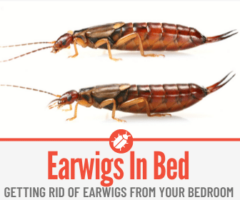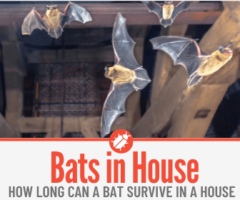 Wondering if the Creepy Centipedes can crawl up the wall, or even worse, crawl into your bed and attack?
Wondering if the Creepy Centipedes can crawl up the wall, or even worse, crawl into your bed and attack?
In this guide you will learn:
- How Exactly Do Centipedes Climb,
- What kind of Walls Centipedes are able to Climb,
- Can Centipedes Climb into beds & How to keep Centipedes out of your bed,
- What other Surfaces can Centipedes Climb
House centipedes can most certainly climb up walls as long as they are not too smooth.
Beds for Centipedes are also very easy to climb!
The long version of this answer is much more in-depth, so let’s break it down a little bit.
How Do Centipedes Climb?
Much like spiders, pincher bugs and ants, centipedes have sharp claw-like structures on the ends of nearly every one of their legs that allow them to hook onto many different crevices and surfaces and climb many different surfaces.
While many of these surface bumps and crevices are completely invisible to the naked human eye, centipede legs are small enough that they can grab onto these minuscule ledges and use the leverage to propel themselves forward, much like a human climbing a rock wall (except on a significantly smaller scale).
This system is not foolproof however, and some surfaces like certain types of drywall are more difficult or impossible for centipedes to climb successfully.
Although these surfaces are few and far between in an average home.
As a general rule, if you have any sort of textured surfaces or even cabinets and shower curtains in your home, you can expect that house centipedes will be able to climb them rather easily.
Centipedes In your Bed
Can Centipedes Climb into my Bed?
While centipedes generally don’t crawl into your bed with the intention of causing you harm, you may occasionally find yourself sharing the sheets with one of these many legged creatures, even if you’re not aware of it.
Just like drywall and other textured surfaces, centipedes are fully capable of climbing up any piece of fabric including bed sheets and blankets, which ultimately gives them ample access to all of the nooks and crannies your bedding provides.
Why Do Centipedes Crawl in your Bed?
Centipedes can sense the heat signature of your body as you lay in bed at night, which is what draws them farther into your home and into your bed.
What if they crawl on me while I sleep…
While they are not malicious and they will not bite if you don’t bother them, they can and will crawl on you to get to their desired location.
Should one crawl on you in the middle of the night it is always best to move as gently as possible, as centipedes will bite should they feel threatened.
Thankfully, this particular bite is not dangerous in any way, although you could be in for a rude awakening should you accidentally roll over on top of one.
Related: Earwigs in Beds
Keeping Centipedes Out of your Bed
Keeping centipedes out of your bed is much like keeping away the spiders, clean bedding is helpful (try to wash bedding every week to eliminate any insects that may have crawled up into the sheets without your knowledge) and preventing them from entering the home is the best method of keeping them away.
Regular pest control is effective against centipedes and may prevent them from entering the house and getting them in your bed.
Can Centipedes Climb Walls?
Yes, centipedes most certainly can climb walls, both internal and external.
They can also crawl up doorframes, desks and tables, as well as crawl across most ceilings if the ceilings have enough texture to them.
How Do Centipedes Climb Walls
Common house centipedes have claw-like appendages on the ends of their legs that allow them to hook onto many different surfaces.
While many of these surface bumps are completely invisible to the naked eye, centipede legs are minuscule enough that they can grab onto these nearly invisible ledges and use the leverage to pull themselves forward.
For drywall specifically, it is very difficult to get perfectly smooth, meaning centipedes have plenty of diverse places to grip even if the wall appears completely smooth to the human eye.
Can Centipedes Climb Smooth Walls?
Centipedes have no trouble climbing smooth walls, as even walls or surfaces that appear perfectly smooth to the human eye can still have textures that allow the legs of the centipede to grip and propel themselves forward.
While climbing smooth walls may not be quite as easy as textured walls, it is definitely still possible for centipedes to manoeuvre up them!
Other Surfaces Centipedes Can Climb
Up the Drains
Centipedes can very easily climb up drains in plumbing such as sinks, bathtubs and toilets, in fact that’s one of the more common ways that they might find themselves living inside your humble abode.
As long as there’s no water running at the time they are trying to enter, the metal on the inside of a drain is rough enough that they can pull themselves up with ease, much like they can do with drywall and wood surfaces!
Ceramic/ Porcelain
Due to the smooth texture of porcelain, centipedes are virtually unable to dig their feet into any ledges, cracks or crevices in the material, Therefore rendering them unable to climb porcelain or ceramic items such as tiles.
As a general rule, you will not be able to find any centipedes crawling up toilet seats, bathtub edges or even sinks if they are porcelain or ceramic and don’t have anything attached to them.
Metal
Depending on the texture and smoothness of the metal, Centipedes may or may not be able to climb up easily on metal.
If the metal surface in question is more of a rough type of metal (for example a ramp or handlebar), they will be able to crawl up just like other rough surfaces.
However, if the metal is smooth like a car door they will most likely be unable to climb due to the fact that there wouldn’t be enough spots for them to grip onto the metal.
Plastic
Similarly to metal and how texture affects the centipede’s ability to climb, the texture of the plastic surface can also cause issues for centipedes.
If the texture of the plastic is more on the rough side, It will surely be no problem for the centipedes to climb fairly easily.
However, if the plastic is overly smooth (for example a poster on the wall), It will render the centipedes incapable of climbing up the surface, as there’s nowhere for them to hook their feet and propel themselves forward.
Centipede Myths and Legends
Do Centipedes Crawl in Your Ears?
While the technical answer to this question is yes, centipedes can most certainly crawl in your ears, it is highly unlikely for something like this to actually happen to the average person.
There are many reasons why this is not a plausible scenario, although the major one is earwax and how it builds up in the ear.
One of the main purposes for this wax is actually insect repellent, as the more wax is in your ear canal, the less room there is for things to crawl in there.
While there have been reported incidents of centipedes crawling into eardrums, it is highly unlikely and not something you would need to worry about on a regular basis.
Do House Centipedes Crawl on You?
Yes, house centipedes can and will crawl on you, although they will more than likely do no harm as long as you don’t make them feel threatened.
While these creatures tend to bite if they feel like they are in harm’s way, they are otherwise docile and a bite from a house centipede will not harm you in any way.
Can Centipedes Climb Out of a Vacuum?
While most vacuum cleaners have rotating blades and brushes that kill insects as they enter the machine, should a centipede survive the ordeal they could potentially crawl back out through the vacuum hose if the bag is not immediately disposed of upon finishing vacuuming.
To circumvent this problem, run the vacuum for a few extra seconds after sucking up an insect or scoop up the centipede and take it outside as they are harmless to humans.
Can Centipedes Climb Air Mattresses?
Just like any other fabric surfaces, centipedes could very easily climb up air mattresses.
While they may struggle to crawl up the plastic edge if it doesn’t have sheets on it, any form of bedding or blankets will make it much easier for them to climb.






